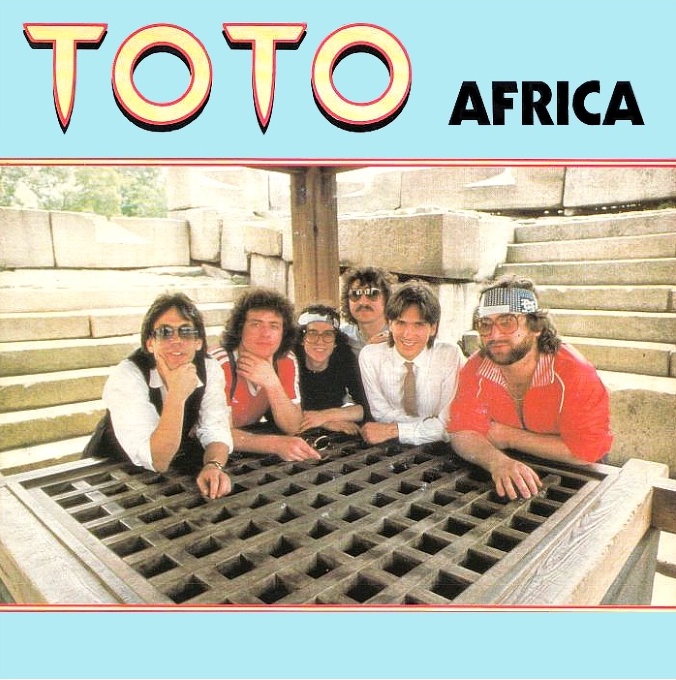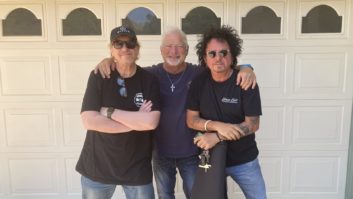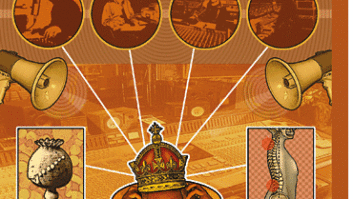 At the 1982 Grammys, accepting Toto’s sixth award of the night, David Paich raised the award in the air and said, “We’d like to thank Robert Hilburn for believing in us,” a sarcastic salute to the Los Angeles Times music critic who took every opportunity to slam the band. Even when the article wasn’t about the Southern California group, Hilburn would find a way to bring them up as a negative example. And he wasn’t the only one. Ironically, because of their mastery of their instruments and their profile as studio aces, critics then — and still — decided the group was too polished and treated them as if they were some kind of pre-fabricated band, a la The Monkees.
At the 1982 Grammys, accepting Toto’s sixth award of the night, David Paich raised the award in the air and said, “We’d like to thank Robert Hilburn for believing in us,” a sarcastic salute to the Los Angeles Times music critic who took every opportunity to slam the band. Even when the article wasn’t about the Southern California group, Hilburn would find a way to bring them up as a negative example. And he wasn’t the only one. Ironically, because of their mastery of their instruments and their profile as studio aces, critics then — and still — decided the group was too polished and treated them as if they were some kind of pre-fabricated band, a la The Monkees.
Not true. These guys started out as a garage band well before their musicianship gained them attention in the studios. And why should having the talent to play with such a variety of artists as Warren Zevon, Paul McCartney, Cher, Cheap Trick, Joni Mitchell, Steely Dan, Tommy Bolin, David Gilmour, Alice Cooper, Bob Seger, George Duke, Michael Jackson and Michael McDonald (the list goes on) mean they weren’t capable of creating a great band sound?
But that night in February 1983, even the critics couldn’t keep Toto from getting their just desserts. Toto took home five Grammys: Record of the Year (“Rosanna”), Best Instrumental Arrangement with a Vocal (“Rosanna”), Album of the Year (Toto IV), Producer of the Year (for Toto IV) and Best Engineered Recording (Toto IV).
It was no surprise to engineer Al Schmitt. “When we started that album, the first track we did was ‘Rosanna’ — and it was the second take, with the improv creative piano solo on the way out — and I think the second track we did was ‘Africa,’” he recalls. “I had a friend who said to me, ‘Next time you’re going to be up for a Grammy, let me know. I want to go to the Grammys. Right after we cut that second track, I called my friend and said, ‘Start getting your tickets.’ It was just magic.”
Paich recalls writing “Africa” on his living room piano. “Over many years, I had been taken by the UNICEF ads with the pictures of Africa and the starving children. I had always wanted to do something to connect with that and bring more attention to the continent. I wanted to go there, too, so I sort of invented a song that put me in Africa. I was hearing the melody in my head and I sat down and played the music in about 10 minutes. And then the chorus came out. I sang the chorus out as you hear it. It was like God channeling it. I thought, ‘I’m talented, but I’m not that talented. Something just happened here!’” Paich then proceeded to work on the lyrics for another six months. He brought the skeleton to drummer Jeff Porcaro with the idea of having percussion being an integral part of the composition. “Jeff got out African sticks with bottle caps that his dad [Joe Porcaro] and Emil Richards [both percussionists] used on National Geographic films. He brought in a marimba and a wooden xylophone kind of thing. This was pre-synthesizer. We didn’t have samples back then. You’re hearing bass marimba, that other instrument, and you’re hearing probably one of the first loops that was ever done.”
“I was about 11 when the New York World’s Fair took place and I went to the African pavilion with my family,” Jeff Porcaro, who died in August 1992, told me in a 1988 interview for Modern Drummer magazine. “I saw the real thing; I don’t know what tribe, but there were these drummers playing and my mind was blown. The thing that blew my mind was that everybody was playing one part. As a little kid in Connecticut, I would see these Puerto Rican and Cuban cats jamming in the park. It was the first time I witnessed somebody playing one beat and not straying from it, like a religious experience, where it gets loud and everyone goes into a trance. I have always dug those kind of orchestras, whether it be a band or all drummers, where a bunch of guys are saying one thing. So when we were doing ‘Africa,’ I set up a bass drum, snare drum and a hi-hat, and [percussionist] Lenny Castro set up right in front of me with a conga. We looked at each other and just started playing the basic groove — the bass drum on 1, on the ‘and’ of 2 and 3. The backbeat is on 3, so it’s a half-time feel, and it’s 16th notes on the hi-hat. Lenny started playing a conga pattern. We played for five minutes on tape — no click, no nothing. We just played. And I was singing the bass line for ‘Africa’ in my mind, so we had a relative tempo.
“Lenny and I went into the booth and listened back to the five minutes of that same boring pattern,” Porcaro said. “We picked out the best two bars that we thought were grooving and we marked those two bars on tape. We made another mark four bars before those two bars. Lenny and I went back out; I had a cowbell, Lenny had a shaker. They gave us two new tracks and they gave us the cue when they saw the first mark go by, where Lenny and I started playing to get into the groove, so by the time that fifth bar came, which was the first bar of the two bars we marked as the cool bars we liked, we were locked, and we overdubbed shaker and cowbell. So there was bass drum, snare drum, hi-hat, two congas, a cowbell and a shaker. We went back in, cut the tape and made a one-bar tape loop that went ’round and ’round and ’round.
“We took that tape, transferred it onto another 24-track for six minutes, and David Paich and I went out in the studio. The song started and I was sitting there with a complete drum set and Paich was playing. When he got to the fill before the chorus, I started playing the chorus, and when the verse or the intro came back, I stopped playing. Then we had piano and drums on tape. Then we had to do bongos, jingle sticks and big shakers doing quarter notes, maybe stacking two tracks of sleigh bells, two tracks of big jingle sticks and two tracks of tambourines all down to one track. I was trying to get the sounds I would hear Milt Holland or Emil Richards have, or the sounds I would hear in a National Geographic special, or the ones I heard at the New York World’s Fair.”
Schmitt recalls being at Sunset Sound working on the track and remembers Porcaro’s original process going to a 2-track machine. “After choosing the looped bars, we put a music stand out and had the tape go around the music stand and back into the tape machine.”
Then everything else was overdubbed. Paich recorded the opening sound on a Yamaha CS80, “then David Hungate put his bass on, Steve [Lukather] put a guitar on, I put some more piano on,” Paich says. “We did the track and I was still working on the lyrics. Everyone tried to sing the song — there were a lot of lyrics to fit into a small amount of space. Bobby [Kimball] tried to sing it and he couldn’t phrase it right. Steve Lukather tried, but I ended up doing it by default. I’m an Elton John fan and he fits a lot of words into his songs. When we get to the chorus, it’s Bobby, Steve and Timmy Schmidt singing. The legendary Jim Horn came in and played recorders in the second verse.
“We recorded 24-track with lots of slaves,” Paich continues. “We got it from Paul Simon, who I think was the first to do it. As soon as he did the rhythm track, he would put the master away so it wouldn’t get worn down and you’d make another 24-track tape for vocals, one of guitars, et cetera, and we made a lot of those. By then, I had my first little 24-track studio [dubbed Hog Manner] at my house, which was a Trident flexi-mix console, two JBL 4311 speakers and two Ampex M1200s, and we messed around doing overdubs there. We were recording 30 ips, non-Dolby, if you can imagine! There was a Yamaha instrument called a GS1, a prototype for the DX7, which at that time was the new little digital synthesizer, so the kalimba sound you hear is that. And we used a CS80, which is very unique.
“On the vocals, I think we had a U47, probably through an LA-2A limiter. Whenever you hear my lead vocals, they’re tripled. Each line has three vocals on it. I got that from listening to a lot of Beach Boys and Beatles records. I like that layered sound.”
“Then and still today, I’m an SM57 kind of guy,” says Lukather. “I’m a big Shure fan when it comes to guitar amps.”
“On the guitar, we used a close mic on the amp and then we had a mic about 15 feet back for room ambience,” Schmitt adds.
“It was a time when we wanted to experiment a lot,” Lukather recalls. “We lived in the studio. It was before any of us were married and had kids, so we rented a Winnebago and had it in the parking lot at Sunset Sound so we didn’t have to go home. We would record all day and all night and if anyone wanted to sleep, they could go into the Winnebago.”
Greg Ladanyi then came in to mix the album. “I think we used three 24-track machines for ‘Africa’ and ‘Rosanna,’ which was something a little bit ahead of its time,” he says. “We were at the Sound Factory. We had to mix ‘Africa’ in sections because the console wasn’t big enough — it didn’t have enough faders for the amount of tracks that were on the record. We had to mix sections and I had to edit the 2-track together to complete the mixes — the verses got mixed, the chorus would go by and then once the verses were mixed, we mixed the choruses and cut the choruses into the verses. The guys in the room were involved in moving faders because we had no automation on the console then. I would be mixing and I’d have Lukather on one side of the console and Paich or Porcaro on the other side of the console and we would do the rides all live. We kept doing the mixes over and over until we got the rides the way we wanted to hear them.
“We used the Eventide Harmonizers for chorusing and harmonizing, a lot of analog effects like tape delay and ¼-inch slap,” Ladanyi continues. “There was Publison and the Sound Factory had the great EMT 140 plates, so all the reverb came from pretty much that. So much of the stuff has come and gone now.
“One other cool thing about the record is something we need to go back to,” Ladanyi says. “The lack of compression used on the final process for the record to be pressed was not an issue like it is today, so the great dynamics of Toto as a band were really felt and heard by the end-user. Today, almost every record you hear is so compressed. A musician’s ability to play with their feel is all about their dynamic range, and when that gets taken out of the mix, the end-user has no relationship with the musician or artist and how they feel things. That record had all that. That was a great record, and it’s still the record that I hear on the radio when I travel the world, even in places like South Korea or South America.”
“Africa,” which went to Number One at the end of 1982, is creative, dynamic proof that critics aren’t always right. “If the critics had any power at all, we would have been over with 25 years ago,” Lukather says. “We’re just here to piss them off and remind them that some of us still believe you have to play good to be successful.” [Laughs]
Toto is currently working on a new album, about which Lukather says, “It’s all the original guys, except, of course, for our brother Jeffrey,” says Lukather. “But he’s always in the room anyway. The other day, we were working with Pro Tools and we were able to immediately go back and listen to a detailed balance of the vocals and it was going by so fast. And Paich said, ‘We could have really used that in 1981.’ Technology is great, Pro Tools is great, but it also enables people who can’t play and can’t sing to make records. If you give technology to the people who can really play and not use it as a crutch but use it as a tool, then it’s awesome.”







